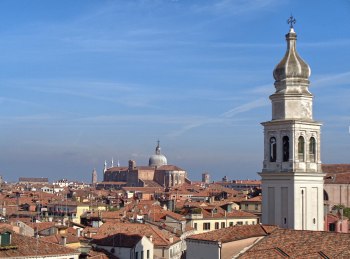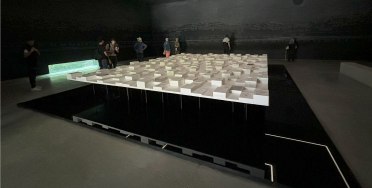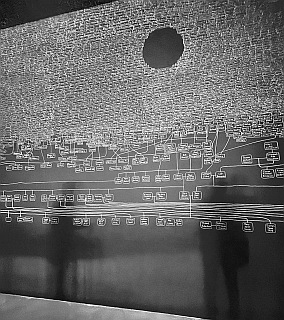Review of Art Exhibition
The review below was created specifically for this website. Any external links are for information only and such content is not the responsibility of the authors.
20.04.2024 - 24.11.2024 'Kith and Kin' by Archie Moore, Australian Pavillion, Biennale di Venezia
 Walking into the Australian Pavillion at the Biennale, after wading through tourists and after days of exploring a thousand years of Venetian dominance and wealth, which is now sinking slowly into the lagoon, is surreal.
Walking into the Australian Pavillion at the Biennale, after wading through tourists and after days of exploring a thousand years of Venetian dominance and wealth, which is now sinking slowly into the lagoon, is surreal.
There are, in my humble opinion, many Indigenous artworks that are more instantly appealing than the installation Archie Moorie created for the Australian Pavillion. His work, however, stands out in its stark demarcation of the black/white divide and in its austere elegance. White chalked texts on black walls label past Indigenous people, his ancestors - not with their own names but with bastardized versions or random names or none - showing the superficial White dominance over Indigenous lives. The names run up the walls and flow over onto the ceiling, growing fainter but not disappearing.
 Intruding into this large space, dozens of stacks of white paper are arranged in geometrical precision on a floating square table in the centre of the room, each representing a Report of a Royal Commission or other government investigation into deaths in custody or the social injustices that put huge numbers of Indigenous people into prisons. The titles are hard to read, and - appropriately - the stacks are often made of blank white pages, symbolising their secret/confidential nature … or perhaps their impact. The table seems to float in or above a mirroring pool, and the first impression is of pristine disconnection from the black reality on the walls.
Intruding into this large space, dozens of stacks of white paper are arranged in geometrical precision on a floating square table in the centre of the room, each representing a Report of a Royal Commission or other government investigation into deaths in custody or the social injustices that put huge numbers of Indigenous people into prisons. The titles are hard to read, and - appropriately - the stacks are often made of blank white pages, symbolising their secret/confidential nature … or perhaps their impact. The table seems to float in or above a mirroring pool, and the first impression is of pristine disconnection from the black reality on the walls.
 There are two major gaps in the ancestral genealogy shown on the walls; one directly opposite the entrance. An attendant on-site, when asked, said they represent a gap in the records. Archie Moore, however, wrote that 'holes occur in the lineage, signalling the severing of families through massacres, diseases and the deliberate destruction of records'. [www.kithandkin.me/concept]
There are two major gaps in the ancestral genealogy shown on the walls; one directly opposite the entrance. An attendant on-site, when asked, said they represent a gap in the records. Archie Moore, however, wrote that 'holes occur in the lineage, signalling the severing of families through massacres, diseases and the deliberate destruction of records'. [www.kithandkin.me/concept]
Walking inside, from the bright outdoors, feels like entering a dark cave. The table with reports stands out starkly, so the writings on the walls only gradually resolve. Finally, the history of lineage dominates as one turns one’s back on the government reports. Two world-views stand in opposition: the civilized, orderly, bureaucratic, genocidal and euphemistic world of colonialism versus the human, familial, living world where what counts are lives and loves.
Studying the hand-written names, and mis-namings, walking along and along, the weight of lives and deaths presses down. Some artworks invite introspection; some artworks demand analysis; this artwork enforces them. One wishes for some ray of light and hope, some sign of rebirth, but the only hint of hope is the message 'we endure. we are more than you can know.'
Archie Moore himself, and several Indigenous curators, provide 15-20 minute discourses on the artwork here: www.kithandkin.me/discourse
Archie Moore's work won the Golden Lion Award for Best Pavilion of the Biennale.
- The Australian Government 'Creative Australia' sponsor's press release says:
- The Australian Minister for the Arts, Tony Burke MP, told Parliament (with no hint of irony) on 16th May that:
- The jury of the 60th International Art Exhibition of La Biennale di Venezia said:
'Creative Australia is delighted to announce that Archie Moore's exhibition kith and kin at the Australia Pavilion has been awarded the prestigious Golden Lion for Best National Participation at La Biennale de Venezia 2024. This is the first time in history an Australian artist has received this accolade.' [1]
'A lot of people won't be aware of the Venice Biennale, but effectively this is the World Cup for the arts. [...] ‘Kith and kin’ is a sublime expression of Aboriginality but also of the humanity that ultimately connects us all, and all Australians can be rightly proud of this triumph.' [2]
'In this quiet, impactful pavilion, Archie Moore worked for months to hand-draw in chalk a monumental First Nation family tree. Thus 65,000 years of history (both recorded and lost) are inscribed on the dark walls and ceiling, inviting viewers to fill in the blanks and grasp the inherent fragility of this mournful archive. The official documents drawn up by the State float in a moat of water. The result of Moore's intensive research, these documents reflect the high rates of incarceration of First Nations people. […] This installation stands out for its strong aesthetic, its lyricism and its invocation of a shared loss of an occluded past. With his inventory of thousands of names, Moore also offers a glimmer of the possibility of recovery.' [3]
External Reviews
Tello, Verónica. 'Archie Moore, kith and kin.' Published 11 May 2024. See www.memoreview.net/reviews/archie-moore-kith-and-kin-at-venice-biennale-by-veronica-tello
Hill, Wes. 'Archie Moore’s sublime kith and kin is simultaneously sombre and stirring'. Published 22 April 2024. See https://inreview.com.au/inreview/visual-art/2024/04/23/archie-moores-sublime-kith-and-kin-is-simultaneously-sombre-and-stirring/
Junkers, Günter. 'Ein Riesen-Stammbaum auf der ''Biennale'' in Venedig'. Published 23 April 2024, in Zeitgeschichte, Genealogie international. See www.compgen.de/2024/04/ein-riesen-stammbaum-auf-der-biennale-in-venedig/
Buhr, Elke and Silke Hohmann. 'Goldene Löwen in Venedig: Die Fußnote ist jetzt das Zentrum' Published 23 April 2024. See www.monopol-magazin.de/kommentar-loewen-venedig-die-fussnote-ist-jetzt-das-zentrum
'LEBENSLINIEN DER MENSCHHEIT'. Published 22 April 2024. See www.weltkunst.de/ausstellungen/2024/04/lebenslinien-der-menschheit
Wichtigste Preise gehen nach Australien und Neuseeland'. Published 20 April 2024. See www.spiegel.de/kultur/kunstbiennale-in-venedig-wichtigste-preise-gehen-nach-australien-und-neuseeland-a-4746035c-780e-4261-90ba-e8c217931c7b
References
[1] Press Release of 20 April 2024 from 'Creative Australia'. See https://creative.gov.au/advocacy-and-research/events/australia-at-the-venice-biennale/venice-biennale-2024/ Creative Australia is the Australian Government's principal arts investment and advisory body. It was founded as the Australia Council for the Arts in 1968 and established by the Australia Council Act 1975, then renamed in 2023.
[2] The Australian Minister for the Arts, Tony Burke MP, report to Parliament of Australia, 16 May 2024, Hansard transcript
[3] Skopeliti, Clea. 'Artwork commemorating Indigenous Australian history triumphs in Venice' in 'The Guardian' Newspaper, 20 April 2024. See www.theguardian.com/artanddesign/2024/apr/20/artwork-commemorating-indigenous-australian-history-triumphs-in-venice
